Unified Value Proposition

5 Mins
Updated: August 11, 2025
Published: March 29, 2021

The Unified Value Proposition is a Prosci model that represents “change management on a page” and helps practitioners define and position change management at a high level for others. To realize organizational benefits, we need to pay attention to both the technical side and the people side of change. The Unified Value Proposition illustrates this clearly and demonstrates that change management and project management are complementary disciplines with a common objective: successful change.
Change Management on a Page
The Unified Value Proposition is an organizing framework for describing and advancing change. It shows how the technical side and people side of change must come together to ultimately deliver success with a change effort.
The change landscape is littered with examples of initiatives where the technical side was completed effectively—the solution was designed, developed and delivered—but the change was unsuccessful because people did not adopt the solution.
Successful change requires success on both sides. The Unified Value Proposition model is effective for positioning change management and defining its critical contribution to project and organizational outcomes.
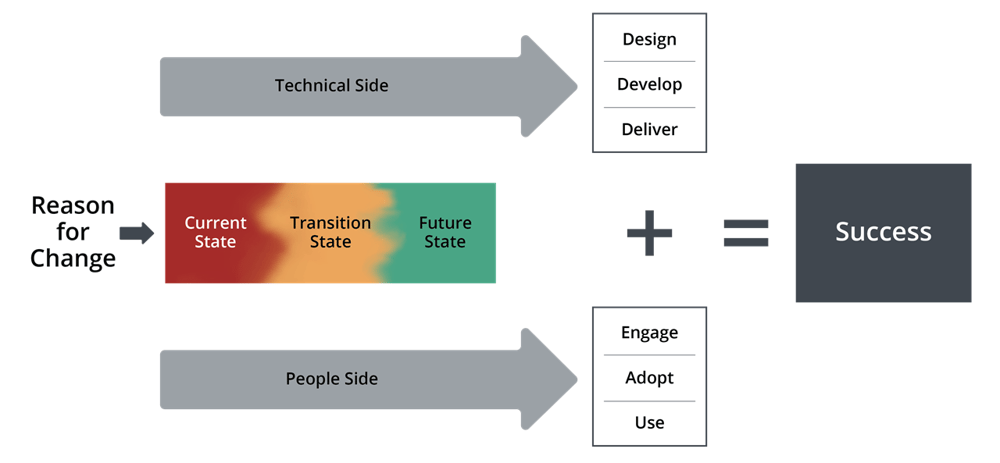
Reason for change
The Unified Value Proposition begins with a reason for change. The reason can come from inside the organization or outside the organization. The reason can be grounded in how things are today (current conditions) or the desire to attain something yet to come (future goals). For most projects and initiatives, there are multiple reasons for change.
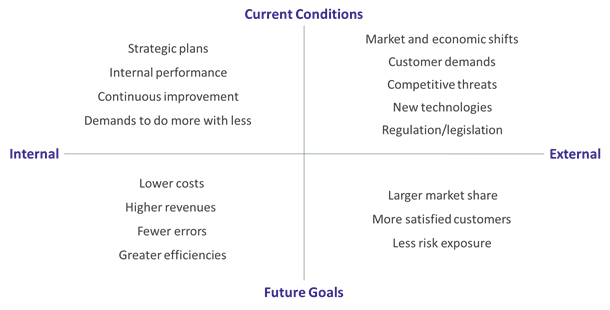
There is always a reason for change—an opportunity to capitalize on, a problem to solve, a chance to improve in a meaningful way. The reason gives the change team needed context to define success for the project or initiative, which is the critical first step in the process for managing change. Success is defined by both the project objectives (what the project achieves and delivers) and the organizational benefits (value realized upon addressing the issue or seizing the opportunity).
States of change
Organizational change progresses through three states in the Unified Value Proposition model: the current state, transition state and future state.
- The current state is the status quo or how things exist today. It is known. It may not be great, but it is familiar and understood by people.
- The future state is the destination. It is unknown, which can create fear and trepidation. The future state is also aspirational, a state where conditions have improved in some marked way as a result of the change initiative.
- The transition state is messy and ambiguous. It is usually not linear and involves some moving forward and backward. Successful change requires stepping out of the current state and effectively navigating the transition state to ultimately reach the envisioned future state.
The way a change progresses through the three states can be sequential, iterative or hybrid in nature. In sequential change, the organization experiences a singular push culminating from a series of progressive steps. We depict sequential change visually with single transition state and future state.
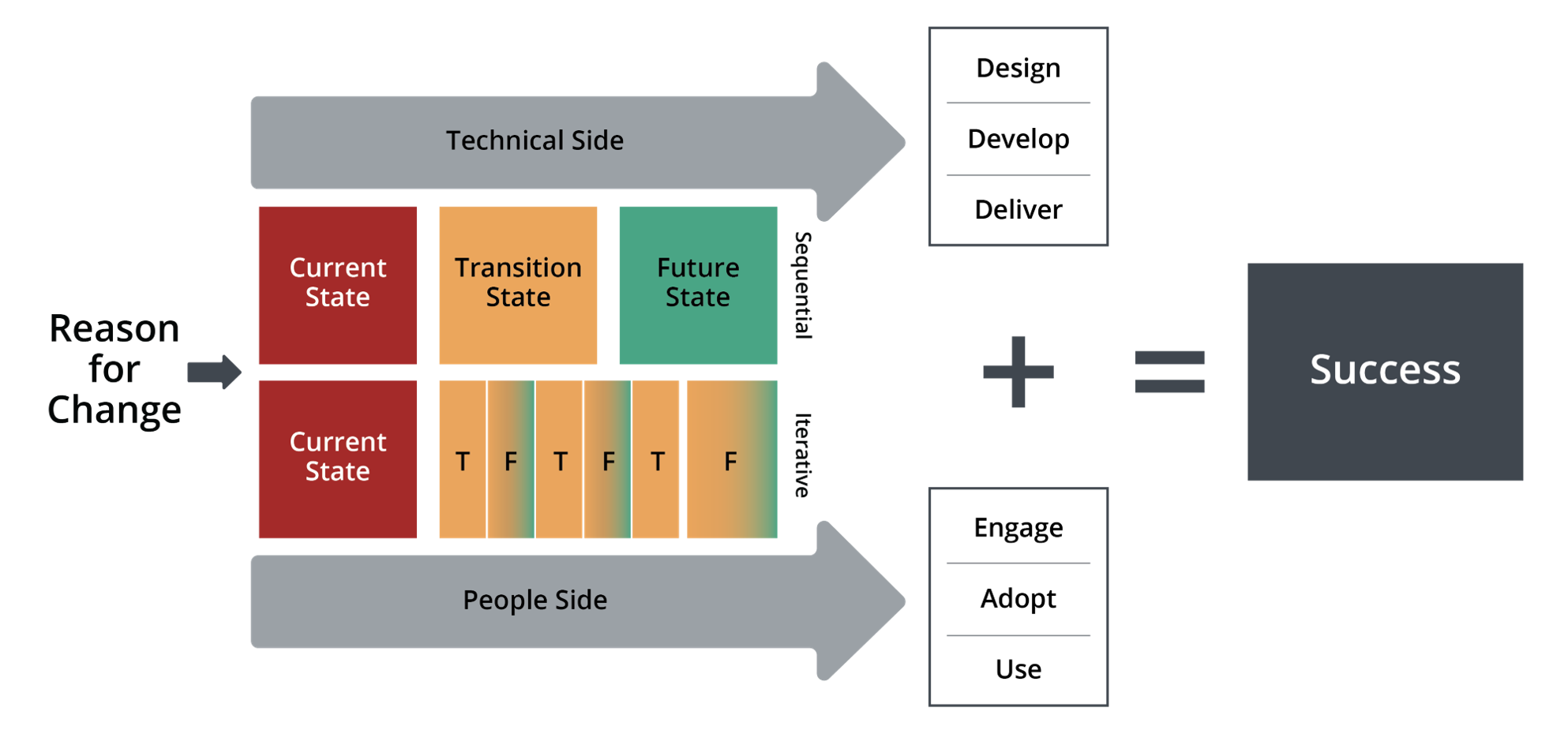
For an iterative change, cycles of development move toward a final, intended outcome with more engagement from the organization during the cycles. Iterative change is shown with multiple transition states and interim future states during each change cycle. Common iterative change approaches include Agile and Continuous Improvement (such as Plan-Do-Check-Act).
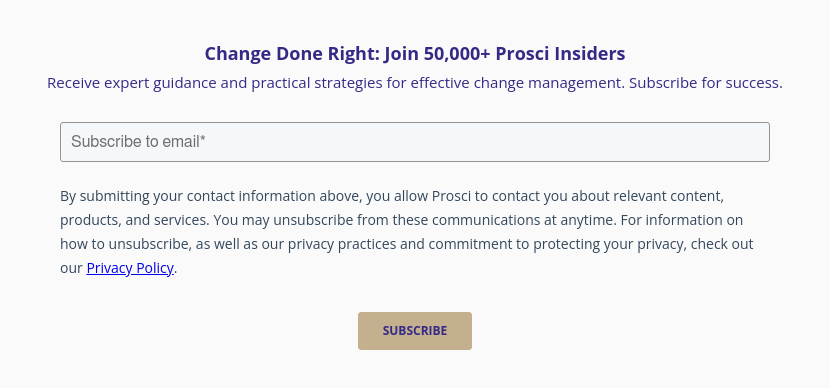
Technical side
The arrow at the top of the Unified Value Proposition is the technical side of the change. This includes all the work and effort to design, develop and deliver a solution that meets the opportunity or issue being addressed. Consider an electronic health records installation. The software and hardware, processes and policies, roles and requirements constitute the technical-side solution. For a merger, the new organization chart, reporting structure, and operational integration plans comprise the technical-side solution. Although many contemporary solutions are embodied or enabled by technology, the technical side of change does not necessarily have to be “technological” in nature or technology based. In a merger, there will be both technological aspects (e.g., an integrated finance system) and non-technological aspects (e.g., cultural alignment and integration) on the technical side of the change.
Some of the more common technical-side changes for which change management is applied today include enterprise resource planning (ERP) applications, new internal communication and collaboration platforms, new product or service launches, adopting hybrid workplaces, and culture initiatives and transformations.
The technical-side solution can cause confusion because people may not think beyond it without help. Although the technical-side solution is easier to understand and often more tangible, it only represents half of the change equation. Regardless of the approach taken on the technical side of the change, a solution that is designed, developed and delivered to meet specifications without a complementing people-side solution throws the Unified Value Proposition off balance, putting change success in peril. A technical-side solution that people do not engage, adopt and use offers little to no value to an organization. Even the best technical-side solution needs a people-side approach to achieve the adoption and usage required to realize intended benefits and achieve success.
People side
The bottom arrow of the Unified Value Proposition represents the people side of the change. This includes the effort to ensure that the people who must do their work differently because of the technical-side solution will in fact engage, adopt and use it.
People do not simply adopt and proficiently use a solution because it is installed for them. Effectively adopting a new process, using a new tool, or demonstrating a new mindset is an individual journey. Every individual must move through the change process to reach their own personal future state in support of the organization’s future state.
The Prosci ADKAR Model comprises five elements of successful individual change: Awareness, Desire, Knowledge, Ability and Reinforcement. Effective change management helps ensure that people can move through each element successfully.
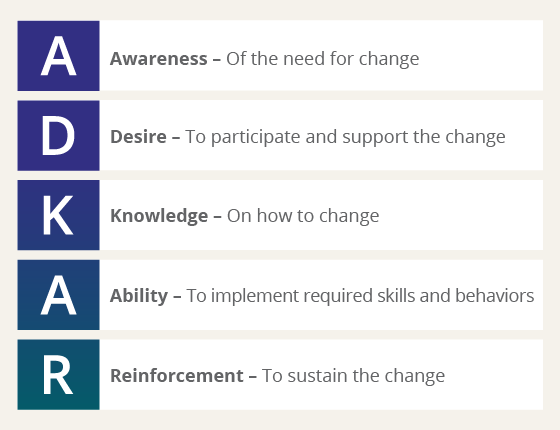
Change management is the application of a structured process and set of tools for leading the people side of change to achieve a desired outcome. From an organizational perspective, change management addresses the people side of the Unified Value Proposition by providing a structured approach for enabling successful individual change at scale.
The change practitioner’s role is to apply a methodology, structured process, and robust toolset to improve adoption and usage of the technical-side solution. The change practitioner also works to activate a system of people, including sponsors and people managers, to carry out the employee-facing activities involved. And when the organization achieves a predetermined level of success with the change, the people side includes a plan to support sustained outcomes and conclude the change management work, formally moving from the transition state into the new future state.
Applying a structured and intentional approach to change management reduces the costs, risks and negative consequences of poorly managed change. And Prosci’s Best Practices in Change Management research consistently shows that change management significantly improves the likelihood of change success.
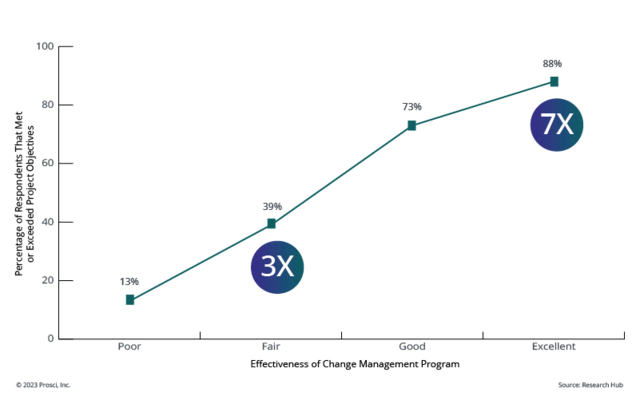
Success
When the technical side and people side work together effectively, the Unified Value Proposition model ends with Success. The change achieves success by meeting or exceeding project objectives and delivering the expected organizational benefits.
Success will depend on the specific change and the intended performance improvement desired in the future state. Success for a merger differs from success for an electronic health records program. A clear definition of success is a critical first step in organizational change. It is so important, the Prosci Change Triangle (PCT) Model places it at the center of the model.
Separate in Theory, Integrated in Practice
“There is nothing as practical as a good theory.” – Kurt Lewin, 1943
In the Unified Value Proposition, the technical side and people side of change are represented separately as arrows on either side of the states of change. In practice, the technical side and people side of change are most effective when fully integrated. Prosci’s Best Practices in Change Management research revealed that participants who integrated project management and change management reported meeting or exceeding project objectives more often than those who did not.
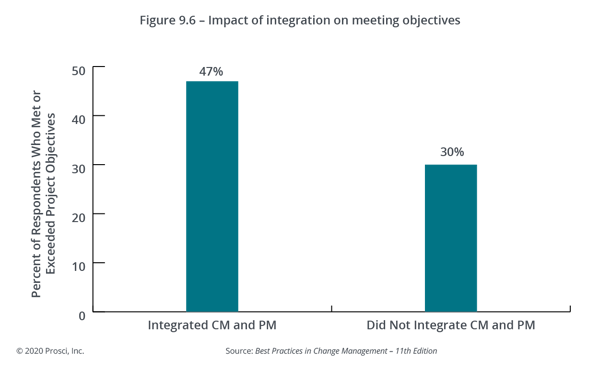
Project management and change management are complementary disciplines with a common objective. Project management prepares the solution for the organization while change management prepares the organization for the solution. The Unified Value Proposition describes the common objective—success—which both project management and change management aim to deliver, setting the foundation for collaboration and integration.
Integrated approach
Integrating project management and change management in the real world is a practical matter requiring structure and intent. In the Prosci Methodology and Prosci Change Triangle (PCT) Model, achieving an integrated approach for organizational change occurs along three dimensions: people, process and tools.
- People – Who does the work, and the collaboration and partnership between the project team and the change practitioner
- Process – The sequences of tasks and activities of the technical and people sides to advance the change in alignment
- Tools – What is used to move the change forward, including commonly integrated tools such as a communications plan, timeline and risk log
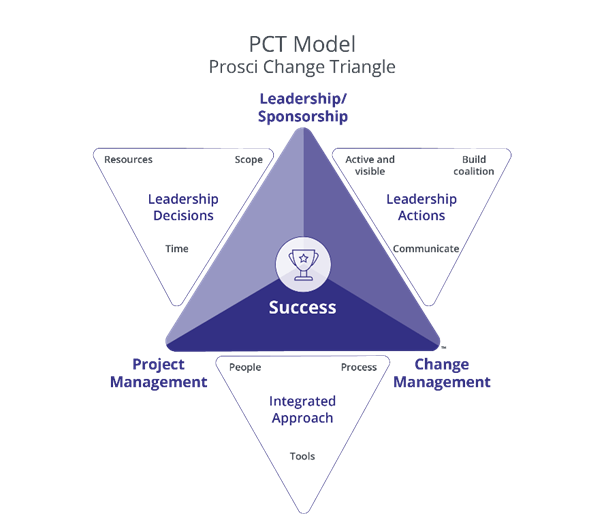
Using the Unified Value Proposition
The Unified Value Proposition can be used by change practitioners in numerous ways to improve change outcomes. It helps describe change and the various aspects of successful change clearly to build a shared view among team members, sponsors and change practitioners. The Unified Value Proposition is also helpful for troubleshooting. Examining each of the aspects enables practitioners to identify gaps and risks to develop and take corrective actions. And finally, Unified Value Proposition offers a holistic view of change, enabling alignment across an organizational project or initiative.



